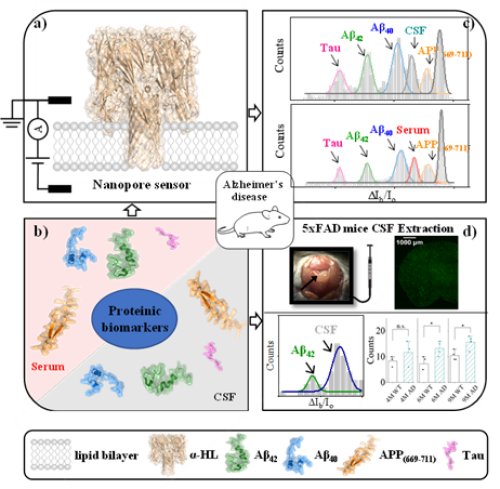

Alzheimer’s disease (AD) is one of the most common forms of dementia. It is a slowly progressive neurologic disorder characterized by the formation of plaques and neurofibrillary tangles due to the accumulation of amyloid-beta peptides (Aβ) and microtubule protein (Tau) in the brain. Aβ is produced by transmembrane protein amyloid precursor protein (APP) in neurons. Enzymes like γ-secretase digest APP at multiple sites, producing a variety of Aβ peptides, including Aβ42, Aβ40, and APP(669-711). Due to matrix interference, detection methods for those protein biomarkers in body fluids are limited. Commonly used methods often require antibody modification or fluorescent labeling. Furthermore, subtle differences in protein sequences make it more challenging to detect and differentiate multiple biomarkers.
Recently, scientists in Chongqing Institute of Green and Intelligent Technology, and Brain Cognition Brain Disease Institute, Shenzhen Institutes of Advanced Technology, Chinese Academy of Sciences, opted for a nanopore sensor that utilizes alpha-hemolysin (α-HL) to construct the transmembrane protein architecture in vitro. Through creating a highly sensitive biological α-HL nanopore sensor detection platform, this label-free method is capable of simultaneously identifying pathogenic proteins (Aβ42, Aβ40, APP(669-711), and Tau) of Alzheimer’s disease (AD) at the single-molecule level, in cerebrospinal fluid and serum. In addition, the method can detect age-dependent changes in Aβ levels in AD mice models, demonstrating reliability comparable to established ELISA assays and brain plaque-staining confocal imaging. Notably, this method achieves significant advancements in detecting 2.1 pM Aβ42 and 1.5 pM APP(669-711), as well as 627 fM Aβ40 in serum. This improvement in nanopore technology addresses the challenges of detecting Aβ and Tau alterations in complex biological samples and differentiates between similar protein sequences. The study marks a significant advancement in the analysis of pathogenic proteins in physiological samples, also offering a powerful tool for AD research and diagnostics.
This work entitled “Multianalyte Nanopore Detection of Alzheimer’s Biomarkers: A Label-Free Platform with Improved Sensitivity and Range” is published on Advanced Healthcare Materials. The work was supported by the National Key Research and Development Program of China, Chongqing Talents-Exceptional Young Talents Project, Youth Innovation Promotion Association of Chinese Academy of Sciences (2022388) and the support from Shenzhen Key Laboratory of Translational Research for Brain Diseases (No. ZDSYS202008328154800001) and Guangdong Basic and Applied Basic Research Foundation (2021A1515110912). Article linkage: https://advanced.onlinelibrary.wiley.com/doi/10.1002/adhm.202405058

Figure 1. Multianalyte Nanopore Detection of Alzheimer’s Biomarkers.